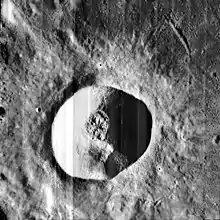Dionysius (crater)
Dionysius is a lunar impact crater that lies on the western edge of the Mare Tranquillitatis. It was named after Dionysius the Areopagite.[1] To the southeast is the crater pair of Ritter and Sabine. Just to the northwest is the system of rilles designated Rimae Ritter. These clefts follow a generally northwest direction.
 Lunar Orbiter 4 image | |
| Coordinates | 2.8°N 17.3°E |
|---|---|
| Diameter | 18 km |
| Depth | 2.7 km |
| Colongitude | 343° at sunrise |
| Eponym | St. Dionysius |



The rim of Dionysius is generally circular and shows little sign of wear. The crater possesses a small ray system with a radius of over 130 kilometers. The formation has a high albedo and appears bright when the Sun is nearly overhead during a full Moon. It is surrounded by a bright halo, with darker material farther out. Some darker deposits are in the form of relatively rare dark rays.
Satellite craters
By convention these features are identified on lunar maps by placing the letter on the side of the crater midpoint that is closest to Dionysius.
| Dionysius | Latitude | Longitude | Diameter |
|---|---|---|---|
| A | 1.7° N | 17.6° E | 3 km |
| B | 3.0° N | 15.8° E | 4 km |
References
- "Dionysius (crater)". Gazetteer of Planetary Nomenclature. USGS Astrogeology Research Program.
- Andersson, L. E.; Whitaker, E. A. (1982). NASA Catalogue of Lunar Nomenclature. NASA RP-1097.
- Bussey, B.; Spudis, P. (2004). The Clementine Atlas of the Moon. New York: Cambridge University Press. ISBN 978-0-521-81528-4.
- Cocks, Elijah E.; Cocks, Josiah C. (1995). Who's Who on the Moon: A Biographical Dictionary of Lunar Nomenclature. Tudor Publishers. ISBN 978-0-936389-27-1.
- McDowell, Jonathan (July 15, 2007). "Lunar Nomenclature". Jonathan's Space Report. Retrieved 2007-10-24.
- Menzel, D. H.; Minnaert, M.; Levin, B.; Dollfus, A.; Bell, B. (1971). "Report on Lunar Nomenclature by the Working Group of Commission 17 of the IAU". Space Science Reviews. 12 (2): 136–186. Bibcode:1971SSRv...12..136M. doi:10.1007/BF00171763.
- Moore, Patrick (2001). On the Moon. Sterling Publishing Co. ISBN 978-0-304-35469-6.
- Price, Fred W. (1988). The Moon Observer's Handbook. Cambridge University Press. ISBN 978-0-521-33500-3.
- Rükl, Antonín (1990). Atlas of the Moon. Kalmbach Books. ISBN 978-0-913135-17-4.
- Webb, Rev. T. W. (1962). Celestial Objects for Common Telescopes (6th revised ed.). Dover. ISBN 978-0-486-20917-3.
- Whitaker, Ewen A. (1999). Mapping and Naming the Moon. Cambridge University Press. ISBN 978-0-521-62248-6.
- Wlasuk, Peter T. (2000). Observing the Moon. Springer. ISBN 978-1-85233-193-1.
External links
| Wikimedia Commons has media related to Dionysius (crater). |
- Dionysius at The Moon Wiki
- Stratification in a Tranquil Sea, Lunar Reconnaissance Orbiter images of Dionysius
- Wood, Chuck (September 24, 2004). "Regional View (a.k.a. Tranquil Sunshine)". Lunar Photo of the Day.
- Wood, Chuck (December 12, 2006). "How Deep is That Hole". Lunar Photo of the Day. Archived from the original on June 14, 2011. - includes a couple of craters such as Dionysius
